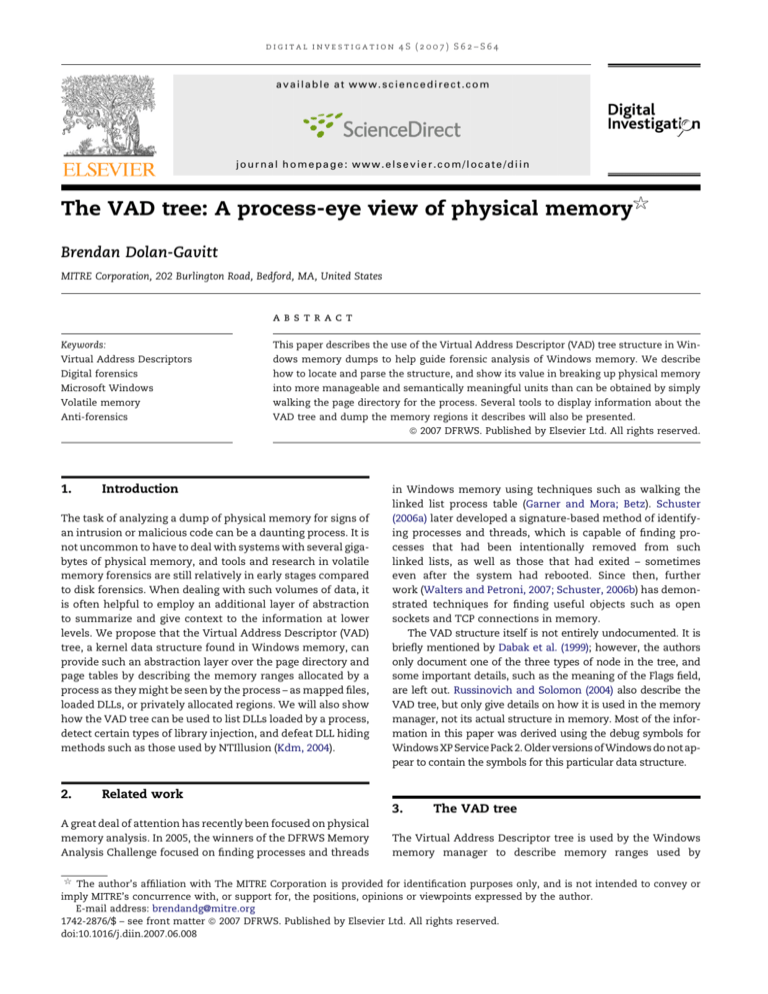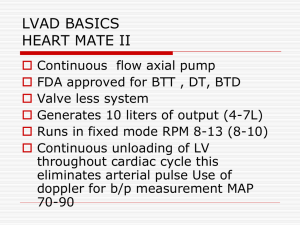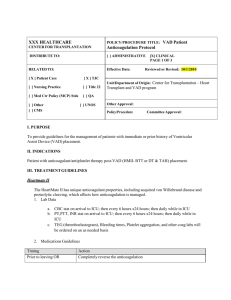
digital investigation 4S (2007) S62–S64
available at www.sciencedirect.com
journal homepage: www.elsevier.com/locate/diin
The VAD tree: A process-eye view of physical memory5
Brendan Dolan-Gavitt
MITRE Corporation, 202 Burlington Road, Bedford, MA, United States
abstract
Keywords:
This paper describes the use of the Virtual Address Descriptor (VAD) tree structure in Win-
Virtual Address Descriptors
dows memory dumps to help guide forensic analysis of Windows memory. We describe
Digital forensics
how to locate and parse the structure, and show its value in breaking up physical memory
Microsoft Windows
into more manageable and semantically meaningful units than can be obtained by simply
Volatile memory
walking the page directory for the process. Several tools to display information about the
Anti-forensics
VAD tree and dump the memory regions it describes will also be presented.
ª 2007 DFRWS. Published by Elsevier Ltd. All rights reserved.
1.
Introduction
The task of analyzing a dump of physical memory for signs of
an intrusion or malicious code can be a daunting process. It is
not uncommon to have to deal with systems with several gigabytes of physical memory, and tools and research in volatile
memory forensics are still relatively in early stages compared
to disk forensics. When dealing with such volumes of data, it
is often helpful to employ an additional layer of abstraction
to summarize and give context to the information at lower
levels. We propose that the Virtual Address Descriptor (VAD)
tree, a kernel data structure found in Windows memory, can
provide such an abstraction layer over the page directory and
page tables by describing the memory ranges allocated by a
process as they might be seen by the process – as mapped files,
loaded DLLs, or privately allocated regions. We will also show
how the VAD tree can be used to list DLLs loaded by a process,
detect certain types of library injection, and defeat DLL hiding
methods such as those used by NTIllusion (Kdm, 2004).
2.
in Windows memory using techniques such as walking the
linked list process table (Garner and Mora; Betz). Schuster
(2006a) later developed a signature-based method of identifying processes and threads, which is capable of finding processes that had been intentionally removed from such
linked lists, as well as those that had exited – sometimes
even after the system had rebooted. Since then, further
work (Walters and Petroni, 2007; Schuster, 2006b) has demonstrated techniques for finding useful objects such as open
sockets and TCP connections in memory.
The VAD structure itself is not entirely undocumented. It is
briefly mentioned by Dabak et al. (1999); however, the authors
only document one of the three types of node in the tree, and
some important details, such as the meaning of the Flags field,
are left out. Russinovich and Solomon (2004) also describe the
VAD tree, but only give details on how it is used in the memory
manager, not its actual structure in memory. Most of the information in this paper was derived using the debug symbols for
Windows XP Service Pack 2. Older versions of Windows do not appear to contain the symbols for this particular data structure.
Related work
3.
A great deal of attention has recently been focused on physical
memory analysis. In 2005, the winners of the DFRWS Memory
Analysis Challenge focused on finding processes and threads
The VAD tree
The Virtual Address Descriptor tree is used by the Windows
memory manager to describe memory ranges used by
5
The author’s affiliation with The MITRE Corporation is provided for identification purposes only, and is not intended to convey or
imply MITRE’s concurrence with, or support for, the positions, opinions or viewpoints expressed by the author.
E-mail address: brendandg@mitre.org
1742-2876/$ – see front matter ª 2007 DFRWS. Published by Elsevier Ltd. All rights reserved.
doi:10.1016/j.diin.2007.06.008
S63
digital investigation 4S (2007) S62–S64
a process as they are allocated. When a process allocates
memory with VirutalAlloc, the memory manager creates an
entry in the VAD tree. The corresponding page directory and
page table entries are not created until the process tries to reference that memory page, which can provide significant
memory savings for processes that allocate a large amount
of memory but access it sparsely (Russinovich and Solomon,
2004, pp. 448–449). The tree itself is a self-balancing binary
tree: at any given node, memory addresses lower than those
contained at the current node can be found in the left subtree
and higher ranges in the right (Fig. 1).
There are three distinct types of VAD node found in Windows 2000 and XP. The structures are named _MMVAD_SHORT,
_MMVAD, and MMVAD_LONG, and their format can be determined
using WinDbg and Microsoft’s debugging symbols under Windows XP SP2. The structures do not appear to have changed
significantly since Windows 2000 SP4. Each structure builds
off the one before it, so an _MMVAD is simply an _MMVAD_SHORT
with several extra fields, such as ControlArea and VadFlags2.
The only reliable mechanism currently known to distinguish
the three structures during parsing is to examine the pool
tag1: _MMVAD_SHORT structures are tagged with ‘‘VadS’’,
_MMVADs with ‘‘Vad’’, and _MMVAD_LONGs with ‘‘Vadl’’.2
Walking the tree is simply a matter of identifying the
_EPROCESS structure for the process of interest (using, for example, Schuster’s (2006a) PTfinder), locating the VadRoot
member (offset 0194 in Windows 2000 SP4, 011c in all versions of XP), and then following each link to the left and right
subtrees until the entire tree is traversed. All addresses are
virtual, so the page directory for the process is also needed
in order to successfully read the tree.3
VAD nodes also reference a number of other kernel structures that may be useful to an investigator. For _MMVADs and
_MMVAD_LONGs, one can find the address of the _CONTROL_
AREA for the memory region.4 From there, if the region is
used for a mapped file (such as a loaded DLL), the corresponding _FILE_OBJECT structure can be referenced and the name
of the file can be extracted. This can provide an investigator
with an alternate method of listing modules loaded by a process, which can then be compared with other methods (e.g.,
those described by Walters, 2006) to find evidence of library injection and hidden modules.
4.
Tools and results
We have developed several tools to allow forensic investigators to examine the VAD tree and dump the memory regions
described out to disk. vadwalk.py walks the entire VAD tree
1
For more information on pool tags and pool allocations in general, consult Schuster (2006b).
2
There is, in fact, one slight complication – Windows 2000 does
not use the ‘‘Vadl’’ tag, but rather indicates that the structure is
an _MMVAD_LONG by setting the ‘‘LongVad’’ flag in the VadFlags2
field and using the ‘‘Vad ’’ tag.
3
The process of translating virtual addresses will not be described here; the procedure is well-documented in Kornblum
(2007), IntelCorporation (2006).
4
Additional information on Control Areas can be found in Russinovich and Solomon (2004, pp. 453–457).
VadS @80e2cd88
00190000 − 001a0000
...
VadS @80e20a88
Vadl @ffa98178
00030000 − 00070000
01000000 − 01013000
...
ControlArea @80d502e0
Flags: Accessed,
HadUserReference,
Image, File
...
...
FileObject @80e170e0
Name:
[...]\notepad.exe
Fig. 1 – A portion of the VAD tree for notepad.exe.
and checks its integrity, and can display the tree in several formats: a tabular listing of each node, an ASCII-art representation, or a Graphviz dotfile. vadinfo.py Prints detailed
information about each node in the VAD tree of a process, including any associated ControlAreas or FileObjects. Finally,
vaddump.py walks the tree and writes each memory range
to disk. The tools work with VMWare vmem images and raw
memory dumps acquired using dd, and support dumps from
Windows 2000 SP4 and all versions of Windows XP.
Although the tools are still at an early stage, they can already be used to easily detect some types of malicious library
injection. For example, the ‘‘user-mode rootkit’’ NTIllusion
(Kdm, 2004) is capable of injecting libraries into processes
and then hiding the injected DLLs by unlinking them from
the module list stored in the Process Environment Block
(PEB). Such modification of the PEB, however, does not affect
the VAD tree, and the loaded DLL can be seen as a mapped
file in the address space of the affected process using
vadinfo; such evidence cannot be found with tools that simply walk the PEB’s module list.
The VAD tree can also provide useful information to an
investigator who already has some idea of what to look
for: if there is a particular string that is known to be an indicator of malicious activity (for example, a domain name
that a trojan uses to ‘‘phone home’’), the memory space of
each process could be dumped, and a string search then performed on the output using a tool like grep or FTimes. Such
attribution of strings to user-space processes is already possible by examining the page directory for the process, and
tools such as AAron Walters’ Volatools (Walters and Petroni,
2007) and Joe Stewart’s pmoddump implement this functionality. By looking at the VAD tree, however, an examiner can
also say whether such strings occurred in a loaded DLL, a dynamically allocated memory region, or the process executable itself.
S64
5.
digital investigation 4S (2007) S62–S64
Anti-forensic attacks
As with other kernel data structures, the VAD tree can be altered by any code running in ring 0. This means that Direct
Kernel Object Manipulation (DKOM) attacks can be carried
out to unlink VAD nodes from the tree and effectively hide
them from forensic techniques that rely on this data structure. For example, a process can allocate a region of memory
using VirtualAlloc and then reference it, forcing the memory
manager to create the corresponding page table entries. The
VAD node that describes the region can then be unlinked;
the memory will no longer be visible from tools such as vadwalk, but the process will still be able to access it normally
(memory reads appear to use the page directory to access
memory first, and the VAD is only consulted if a page fault occurs (Russinovich and Solomon, 2004, p. 448)).
We have successfully tested this attack on Windows XP by
allocating several pages of memory, filling them with a specified value, removing the appropriate VAD entry with WinDbg,
and finally reading the memory from within the process to
verify that it was still accessible. Analysis of the process’s
VAD tree in a physical memory dump did not find the memory
region that had been hidden. Further research is needed to determine what other attacks against the VAD may be possible
and explore ways of mitigating them.
6.
Future work
At the moment, the VAD tree is only available in processes
that are still running; the Windows kernel appears to zero
out the pointer to the VAD root when the process exits. This
limits the usefulness of the technique for examining many
of the processes found by tools such as PTfinder, which can locate processes that are no longer directly referenced by the
kernel. One avenue of future investigation would be to attempt to find a way to recover the unlinked trees in these
cases, allowing access to more detailed information about
processes that are no longer running.
The tools themselves also need significant work to move
them beyond the proof-of-concept stage. In Windows Server
2003 and Windows Vista, the structure of the VAD tree appears
to have changed (Schuster, 2007), and the tools will need to be
updated to reflect the new structure.5 The VAD tools should
also be integrated with an existing volatile memory forensics
framework, such as FatKit (Petroni et al., 2006), which will allow investigators to leverage features like support for invalid
page table entries, as documented by Kornblum (2007), and
thereby get a more complete view of physical memory.
7.
Conclusion
We have shown that examination of the VAD tree can provide
useful information to an investigator such as the pattern of
memory allocations used by a process and files mapped into
its virtual address space. It is also another entry point into
5
This change may correspond to the move to AVL self-balancing
binary trees, as documented in Russinovich and Solomon (2004).
the complex web of linked data structures that allow the kernel
to manage processes, threads, and other objects in Windows.
Although it presently has some limitations, such as the inability to give information about processes that had exited at the
time of the memory dump, we feel that when used in conjunction with other memory analysis techniques, the VAD tree can
shed new light on the behavior of user-space processes.
Acknowledgements
Many thanks go out to Aaron Walters, who read over drafts of
this paper and gave many great suggestions, as well as Andy
Bair, who got me interested in the topic of digital forensics
in the first place.
references
Betz C. DFRWS 2005 forensic challenge answers, <http://www.
dfrws.org/2005/challenge/ChrisBetz-DFRWSChallengeOverv
iew.html>.
Dabak P, Phadke S, Borate M. Undocumented Windows NT. New
York, NY, USA: John Wiley & Sons, Inc., ISBN 0764545698; 1999.
Graphviz, <http://www.graphviz.org/>.
Garner Jr GM, Mora R-J. DFRWS 2005 forensic challenge answers,
<http://www.dfrws.org/2005/challenge/RossettoeCioccolatoResponses.pdf>.
IntelCorporation. Intel64 and IA-32 architectures software
developer’s manual. Santa Clara, CA, USA: IntelCorporation,
<http://www.intel.com/products/processor/manuals/index.
htm>; 2006.
Kdm. NTIllusion: a portable Win32 userland rootkit. Phrack July
2004;11(62).
Kornblum J. Using every part of the buffalo in Windows memory
analysis. Digit Investig J, <http://jessekornblum.com/
research/papers/buffalo.pdf> March 2007.
Petroni Jr NL, Walters A, Fraser T, Arbaugh WA. FATKit: a framework for the extraction and analysis of digital forensic data from
volatile system memory. Digit Investig December 2006;3(4).
Russinovich ME, Solomon DA. Microsoft Windows internals,
Microsoft Windows Server(TM) 2003, Windows XP, and
Windows 2000 (Pro-Developer). 4th ed. Redmond, WA, USA:
Microsoft Press, ISBN 0735619174; 2004.
Schuster A. Searching for processes and threads in Microsoft
Windows memory dumps. In: Proceedings of the sixth annual
digital forensic research workshop (DFRWS 2006); 2006a.
<http://www.dfrws.org/2006/proceedings/2-Schuster.pdf>.
Schuster A. Pool allocations as an information source in Windows
memory forensics. In: Third international conference on ITincident management & IT-forensics; October 2006b.
Schuster A. _EPROCESS version 6.0.6000.16386, <http://computer.
forensikblog.de/en/2007/01/eprocess_6_0_6000_16386.html>;
January 2007.
The FTimes project, <http://ftimes.sourceforge.net/FTimes/
index.shtml>.
Walters A. FATKit: Detecting malicious library injection and
upping the ‘‘anti’’. Technical report. 4TF Research
Laboratories; July 2006.
Walters A, Petroni Jr NL. Volatools: integrating volatile memory
forensics into the digital investigation process. In: Black Hat
DC 2007; 2007.
Brendan Dolan-Gavitt received a BA in Computer Science and Mathematics from Wesleyan University in Middletown, CT in 2006. He currently works at the MITRE Corporation in Bedford, MA.










